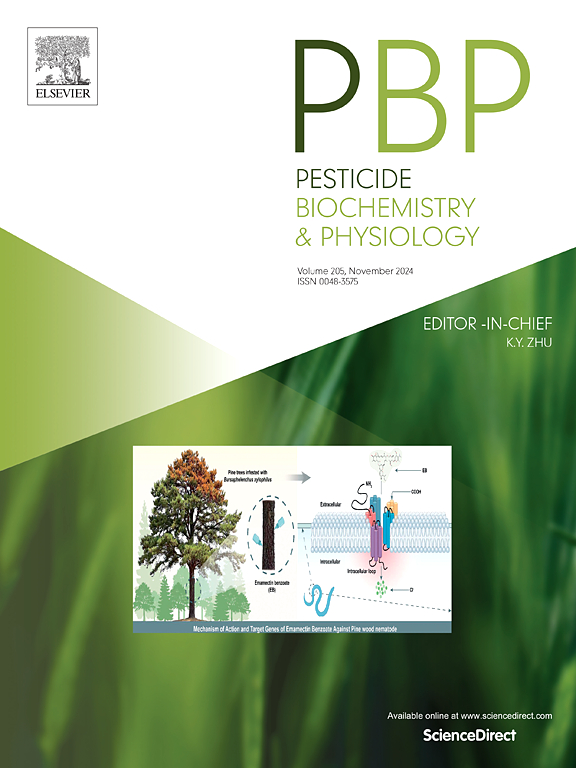Triflumezopyrim-induced changes in the flight ability and energy metabolism of the brown planthopper, Nilaparvata lugens
IF 4.2
1区 农林科学
Q2 BIOCHEMISTRY & MOLECULAR BIOLOGY
引用次数: 0
Abstract
The brown planthopper (BPH), Nilaparvata lugens Stål, is a migratory pest of rice that exhibits short- and long-winged polymorphisms. The increased prevalence of long-winged individuals signals either immigration from external sources or imminent emigration from local populations. The migratory behavior of BPH is contingent upon its intrinsic flight capabilities, which have historically been managed through chemical pesticides. However, the challenge of mitigating pesticide resistance and rebound in BPH populations poses a significant concern for agricultural stakeholders. In this investigation, triflumezopyrim (TFM) was shown to be an effective agent in diminishing the flight capacity of BPH. Sublethal (0.249 mg/L) and median lethal concentration (0.571 mg/L) of TFM were used to construct a transcriptional profile of the long-winged form of BPH at 72 h post-emergence. Furthermore, following TFM exposure, a marked reduction in the flight performance of BPH was observed, and this was accompanied by elevated trehalose levels, attenuated trehalase activity, and a decrease in glucose, glycogen, and total sugar concentrations. In response to TFM, there was a substantial increase in reactive oxygen species within flight muscles, heightened H2O2 levels, and a reduced GSH/GSSG ratio. Histopathological examination of flight muscle sections showed that the flight muscles of TFM-treated BPH exhibited a higher proportion of apoptotic cells as compared to controls, suggesting that TFM impairs the flight capability of BPH. This study elucidates how TFM exposure impacts the flight ability of long-winged BPH and provides transcriptomic data that help clarify the role of TFM role in pest management.

三氟唑吡灵诱导褐飞虱飞行能力和能量代谢的变化
褐飞虱(Nilaparvata lugens stamatl)是一种具有短翅和长翅多态性的水稻迁徙害虫。长翅个体的增加表明要么是外来移民,要么是当地人口即将移民。BPH的迁徙行为取决于其内在的飞行能力,历史上一直通过化学农药进行管理。然而,减轻BPH种群的农药抗性和反弹的挑战引起了农业利益相关者的重大关注。在这项调查中,三氟唑吡灵(TFM)被证明是一种有效的药物,以减少BPH的飞行能力。利用TFM的亚致死浓度(0.249 mg/L)和中位致死浓度(0.571 mg/L)构建羽化后72 h长翅型BPH的转录谱。此外,在TFM暴露后,观察到BPH的飞行性能显着降低,并且伴随着海藻糖水平升高,海藻酶活性减弱,葡萄糖,糖原和总糖浓度降低。在TFM的作用下,飞行肌肉中的活性氧显著增加,H2O2水平升高,GSH/GSSG比值降低。飞行肌切片的组织病理学检查显示,与对照组相比,TFM处理的BPH飞行肌中凋亡细胞的比例更高,这表明TFM损害了BPH的飞行能力。本研究阐明了TFM暴露如何影响长翅BPH的飞行能力,并提供了转录组学数据,有助于阐明TFM在害虫管理中的作用。
本文章由计算机程序翻译,如有差异,请以英文原文为准。
求助全文
约1分钟内获得全文
求助全文
来源期刊
CiteScore
7.00
自引率
8.50%
发文量
238
审稿时长
4.2 months
期刊介绍:
Pesticide Biochemistry and Physiology publishes original scientific articles pertaining to the mode of action of plant protection agents such as insecticides, fungicides, herbicides, and similar compounds, including nonlethal pest control agents, biosynthesis of pheromones, hormones, and plant resistance agents. Manuscripts may include a biochemical, physiological, or molecular study for an understanding of comparative toxicology or selective toxicity of both target and nontarget organisms. Particular interest will be given to studies on the molecular biology of pest control, toxicology, and pesticide resistance.
Research Areas Emphasized Include the Biochemistry and Physiology of:
• Comparative toxicity
• Mode of action
• Pathophysiology
• Plant growth regulators
• Resistance
• Other effects of pesticides on both parasites and hosts.

 求助内容:
求助内容: 应助结果提醒方式:
应助结果提醒方式:


